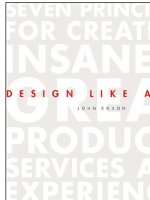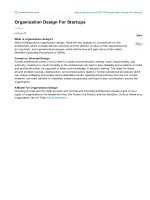AGR5201 lec04 expt design
Bạn đang xem bản rút gọn của tài liệu. Xem và tải ngay bản đầy đủ của tài liệu tại đây (121.09 KB, 34 trang )
AGR5201
ADVANCED STATISTICAL METHODS
Semester 1 2019/2020
Lecture 4
Experimental design:
CRD vs. RCBD
What is an experiment ?
•
A planned inquiry to:
– Obtain new facts
– Confirm or deny the result of previous experiments
•
Results from experiment will aid in administrative decision:
– Recommending a variety, procedure or pesticide
Basic elements in experimental design
•
•
•
•
Experimental unit (E.U)
Treatment
Replications
Randomization
Experimental unit (E.U)
•
Experimental unit:
•
Examples:
– The unit of material which one application of treatment is applied
– An animal (draw blood sample from an animal)
– 10 chickens in a cage (fed on the same diet)
– A row of corn (10 plants/row)
– A pot of bean plants
•
It can be 1 plant/pot or a few plants/pot
Treatment
•
•
Treatment:
– A procedure whose effect is to be measured and compared with other
treatments
Examples:
– Rate of nitrogen 0 kg/ha N, 100 kg/ha N, 150 kg/ha N
– Spraying schedule – 3 times a day, 2 times a day, once a day
– Different temperature 30oC, 35oC, 40oC, 60oC
– The combination of different rate of N and P fertilizer.
Replication
•
•
When a treatment appear more than once
The functions:
– To provide an estimate of experimental error
– Improve precision reduce std. dev. of a treatment mean
Randomization
•
Function: to ensure we have a valid and unbiased estimate of:
– Experimental error
– Treatment means
– Differences among treatment means
Experimental error
•
•
Characteristics of experimental material variations!
•
Experimental error is the error variance or mean square error (MSE) in
ANOVA
•
Experimental error a measure of variation that exists among observation
on experimental unit (E.U) treated alike.
Example:
– Two pots of bean plants (two E.U) that have been treated in the same
treatment produce different yield.
Variations in experimental units:
•
Two main sources:
1.
Inherent variability of material
•
2.
The materials are not uniform
Lack of uniformity in the physical conduct of experiment
•
•
Different environmental conditions (light received, slope area)
Different people measure differently
Example 1
•
•
An experiment was conducted to study the effect of different fertilizer on
corn yield. Three types of fertilizer were used as treatments and there were
four replications in each treatment.
Corn plants were planted in a 6-meter row. After four months of planting, the
whole row will be harvested to determine the yield.
– Experimental unit? The 6-meter row of corn
– Treatment? three types of fertilizer
– # of replications? four
Example 2
•
•
An experiment was conducted to study the effect of three diet
formulations on the production of milk in dairy cows.
Each diet were fed to two cows. After two weeks, the milk were
collected to measure the yield.
– Experimental unit? cow
– Treatment? diet formulations
– Number of replications? two (two cows were fed with each diet)
Hypothesis testing
Ho: there is no different between treatments
Ha: There are differences between treatment
•
•
•
Comparing between treatments
Treatments designed to meet objectives
Must have an experimental design
Steps in hypothesis testing
•
•
•
•
Step 1
Determine your treatments: fertilizer? variety? hormone?
method?
Are you studying ONE factor only – SIMPLEST
Are you studying 2 factors – 2-FACTORIAL experiment – more
difficult than one factor
Are you studying 3 factors – 3-FACTORIAL - more complicated!!
Step 2
•
Determine your EXPERIMENTAL UNIT = the smallest unit that you
apply your treatment
– One pot?
– One plot?
– One plant?
– One animal?
Step 3
•
Determine the number of REPLICATIONS = the number of
experimental units in one treatment
Step 4
•
Determine the EXPERIMENTAL DESIGN = how you
allocate the treatments to the experimental units
Experimental design
•
•
•
Completely randomized design (CRD)
Randomized complete block design (RCBD)
Latin square
Completely Randomized Design (CRD)
•
•
Simplest and least restrictive
Every plot is equally likely to be assigned to any treatment
The layout of CRD
•
The treatments are randomly
T2R4
T3R1
T2R2
T1R1
T3R2
T2R1
T1R3
T2R3
T1R2
T3R4
T3R2
T1R4
assigned to any experimental
plots
•
The treatments are also
replicated to avoid bias
Randomization of treatment in CRD
NOT RANDOM
0N
•
120 N
Replicated but biased
RANDOM
100 N
0N
120 N
100 N
0N
120 N
100 N
0N
•
100 N
120 N
Replicated and randomized
120 N
0N
100 N
100 N
120 N
0N
Advantages of a CRD
•
Flexibility
– Any number of treatments and any number of replications
– Don’t have to have the same number of replications per treatment
(but more efficient if you do)
•
Simple statistical analysis
•
•
Missing plots do not complicate the analysis
– Even if you have unequal replication
Maximum error degrees of freedom
Disadvantage of CRD
•
Low precision if the plots are not uniform
Uses for the CRD
•
If the experimental site is relatively uniform:
– lab
– greenhouse
Design construction
•
•
•
•
No restriction on the assignment of treatments to the plots
Each treatment is equally likely to be assigned to any plot
Should use some sort of mechanical procedure to prevent personal bias
Assignment of random numbers may be by:
–
–
–
lot (draw a number )
computer assignment (Excel)
using a random number table
Linear additive model for a CRD
Yij = µ + τi + εij
Where,
Yij = the observation made on the j
th
experimental unit of the i
th
treatment.
µ = the overall population mean
τi = effect of the i
th
treatment (µi - µ).
εij = the unexplained portion of the observation made on the j
th
i treatment, the residual (Xij-µi).
th
experimental unit of the









